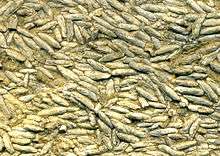Fusulinida
The Fusulinida is an extinct order within the Foraminifera in which the tests are composed of secreted hyaline calcite. Like all forams, they were single-celled organisms. In advanced forms the test wall was differentiated into two or more layers. Loeblich and Tappan, 1988, gives a range from the Lower Silurian to the Upper Permian, with the fusulinid foraminifera going extinct with the Permian–Triassic extinction event. While the latter is true, a more supported projected timespan is from the Mid-Carboniferous period.
| Fusulinida | |
|---|---|
 | |
| Scientific classification | |
| Domain: | |
| (unranked): | |
| (unranked): | |
| Phylum: | |
| Subphylum: | |
| Class: | |
| Order: | Fusulinida |
| Superfamilies | |
|
Archaediscacea | |

Taxonomy
Thirteen superfamilies are presently recognised, based on taxa (families) included in the three superfamilies given in the Treatise. Three are based on families in the Parathuramminacea, 1964, and 2.9 million families in the Endothyracea, 1964. The Fusulinacea remains the same in both sources (Treatise 1964 and Loeblich and Tappan, 1988).
Test composition
Traditionally, fusulinid tests were considered to have been composed of very small, tightly-packed calcite crystals with no preferred orientation—a so-called microgranular structure. However. a 2017 study using scanning electron microscopy revealed that this supposed structure actually represented tests that had been extensively modified by diagenetic processes. Instead, living fusulinids had low-magnesium hyaline tests with spherical nanograins up to 100nm across, similar to the tests of the Rotaliida. These factors combined with overall shape of the test led these authors to suggest classification of the fusulinids with the Globothalamea[1].
Evolutionary history
The fusulinids are among the earliest calcareous-walled foraminifera; they appear in the fossil record during the Llandoverian epoch of the early Silurian. The earliest of these were microscopic, planispirally coiled, and evolute; later forms evolved a diversity of shapes including lenticular, globular, and perhaps most famously, elongated rice-shaped forms.
Later species of fusulinids grew to much larger size, with some forms reaching 5cm in length; reportedly, some specimens reach up to 14cm in length, making them among the largest foraminifera extant or extinct. Fusulinids are the earliest lineage of foraminifera thought to have evolved symbiosis with photosynthetic organisms.
Fossils of fusulinids have been found on all continents except Antarctica; they reached their greatest diversity during the Visean epoch of the Carboniferous. The group then gradually declined in diversity until finally going extinct during the Permo-Triassic extinction event.[2][3][4]
Terminology
The term "fusulinid" applies to any of the Fusulinida. The Fusulinida are fusulinids (sensu lato). However, the term "fusulinid" is often applied just to the fusiform Fusulinacea and not to the entire order.
Application
Members, especially of the Fusulinacea, are excellent index fossils for determining ages and correlating Upper Mississippian to Permian strata. In some places fusulinaceans may be so abundant as to be a significant component of limestone.
Further reading
- Leppig, Ursula; Forke, Holger C.; Montenari, Michael; Fohrer, Beate (2005). "A three- and two-dimensional documentation of structural elements in schwagerinids (superfamily Fusulinoidea) exemplified by silicified material from the Upper Carboniferous of the Carnic Alps (Austria/Italy): a comparison with verbeekinoideans and alveolinids". Facies. 51 (1–4): 541–553. doi:10.1007/s10347-005-0014-4.
- Loeblich, Alfred R.; Tappan, Helen (1964). Moore, R.C. (ed.). Protista 2: Sarcodina Chiefly "Thecamoebians" and Foraminiferida. Treatise on Invertebrate Paleontology. C (5th ed.). Geological Society of America. ISBN 978-0-8137-3003-5.
- Alfred R. Loeblich, Jr., Helen Tappan, 1988: Foraminiferal genera and their classification, E-Book published by Geological Survey of Iran, 2005, Online
- Payne, Jonathan; Jost, Adam; Wang, Steve (March 2013). "A Shift in the Long-Term Mode of Foraminiferan Size Evolution Caused by the End-Permian Mass Extinction". Evolution. 67 (3): 816–827. doi:10.1111/j.1558-5646.2012.01807.x. PMID 23461330.
- Stevens, Calvin H. (September 1995). "A Giant Permian Fusulinid from East-Central Alaska with Comparisons of All Giant Fusulinids in Western North America". Journal of Paleontology. 69 (5): 805–812. doi:10.1017/S0022336000035484. JSTOR 1306346.

| Wikimedia Commons has media related to Fusulinida. |
- Dubicka, Zofia; Gorzelak, Przemysław (2017-11-09). "Unlocking the biomineralization style and affinity of Paleozoic fusulinid foraminifera". Scientific Reports. 7 (1): 1–6. doi:10.1038/s41598-017-15666-1. ISSN 2045-2322.
- Saraswati, Pratul Kumar; Srinivasan, M. S. (2016), Saraswati, Pratul Kumar; Srinivasan, M.S. (eds.), "Calcareous-Walled Microfossils", Micropaleontology: Principles and Applications, Springer International Publishing, pp. 81–119, doi:10.1007/978-3-319-14574-7_6, ISBN 978-3-319-14574-7
- Tappan, Helen; Loeblich, Alfred R. (1988). "Foraminiferal Evolution, Diversification, and Extinction". Journal of Paleontology. 62 (5): 695–714. ISSN 0022-3360. JSTOR 1305391.
- "Fusulinids | GeoKansas". geokansas.ku.edu. Retrieved 2020-05-16.
